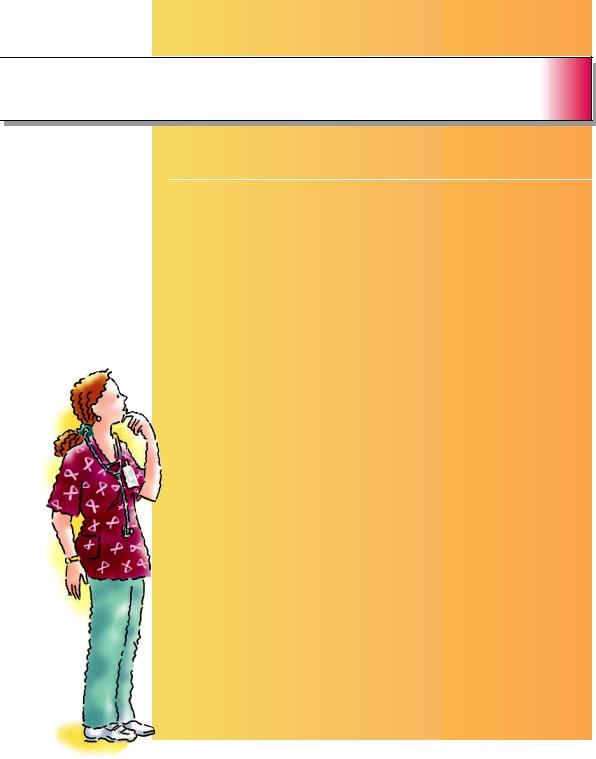
- •Contents
- •Contributors and consultants
- •Not another boring foreword
- •A look at cardiac anatomy
- •A look at cardiac physiology
- •A look at ECG recordings
- •All about leads
- •Observing the cardiac rhythm
- •Monitor problems
- •A look at an ECG complex
- •8-step method
- •Recognizing normal sinus rhythm
- •A look at sinus node arrhythmias
- •Sinus arrhythmia
- •Sinus bradycardia
- •Sinus tachycardia
- •Sinus arrest
- •Sick sinus syndrome
- •A look at atrial arrhythmias
- •Premature atrial contractions
- •Atrial tachycardia
- •Atrial flutter
- •Atrial fibrillation
- •Wandering pacemaker
- •A look at junctional arrhythmias
- •Premature junctional contraction
- •Junctional escape rhythm
- •Accelerated junctional rhythm
- •Junctional tachycardia
- •A look at ventricular arrhythmias
- •Premature ventricular contraction
- •Idioventricular rhythms
- •Ventricular tachycardia
- •Ventricular fibrillation
- •Asystole
- •A look at AV block
- •First-degree AV block
- •Type I second-degree AV block
- •Type II second-degree AV block
- •Third-degree AV block
- •A look at pacemakers
- •Working with pacemakers
- •Evaluating pacemakers
- •A look at biventricular pacemakers
- •A look at radiofrequency ablation
- •A look at ICDs
- •A look at antiarrhythmics
- •Antiarrhythmics by class
- •Teaching about antiarrhythmics
- •A look at the 12-lead ECG
- •Signal-averaged ECG
- •A look at 12-lead ECG interpretation
- •Disorders affecting a 12-lead ECG
- •Identifying types of MI
- •Appendices and index
- •Practice makes perfect
- •ACLS algorithms
- •Brushing up on interpretation skills
- •Look-alike ECG challenge
- •Quick guide to arrhythmias
- •Glossary
- •Selected references
- •Index
- •Notes

PHARMACOLOGIC TREATMENTS
232
What can happen
Adverse cardiovascular effects of magnesium sulfate include diaphoresis, flushing, depressed cardiac function, bradycardia, hypotension, and circulatory collapse. (See Noncardiac adverse effects of magnesium sulfate.)
How you intervene
Keep the following points in mind when caring for a patient receiving magnesium sulfate:
•Monitor the patient’s heart rate, blood pressure, ventilatory rate, ECG, urine output, deep tendon reflexes, and mental status.
•Remember that magnesium sulfate should be avoided in patients with renal disease. Use it cautiously in patients with renal insufficiency and in those taking digoxin.
•Monitor closely for signs and symptoms of hypermagnesemia, such as hypotension, AV block, central nervous system depression, depressed or absent deep tendon reflexes, muscle weakness or paralysis, and respiratory arrest.
•Have I.V. calcium available to counteract the effects of hypermagnesemia.
•Have intubation equipment and a mechanical ventilator available.
•Magnesium sulfate is contraindicated in heart block and in patients with myocardial damage.
Teaching about antiarrhythmics
Here are some important points to emphasize when teaching your patient about antiarrhythmic drugs:
•Take the drug exactly as prescribed. Don’t stop taking the drug without consulting your practitioner.
•Call the practitioner if you experience chest pain, shortness of breath, cough, palpitations, dizziness, fatigue, a weight gain of more than 2 lb (0.9 kg) per day, a very fast or slow heart rate, or a change in the regularity of the heartbeat or if you notice persistent changes you feel might be related to drug therapy.
•See your practitioner for regular checkups, as scheduled. Periodic physical examinations, ECGs, chest X-rays, and laboratory studies will help evaluate the effectiveness of therapy.
•Use herbal preparations with care. Some preparations can cause life-threatening interactions.
Avoid administering magnesium sulfate to patients with renal disease.
Noncardiac adverse effects of magnesium sulfate
In addition to adverse cardiovascular effects of magnesium sulfate, other adverse effects include:
•Central nervous system—drowsiness, depressed reflexes, flaccid paralysis, hypothermia
•Respiratory—respira- tory paralysis
•Other—hypocalcemia.

TEACHING ABOUT ANTIARRHYTHMICS |
233 |
|
That’s a wrap!
Pharmacologic treatments review
Antiarrhythmic drugs
• Classified according to effect on the cell’s electrical activity (action potential) and mechanism of action
Class Ia antiarrhythmics
•Are called sodium channel blockers
•Reduce excitability of cardiac cells and decrease contractility
•Have anticholinergic and proarrhythmic effects
•Show widened QRS complex and prolonged QT intervals on ECG
Quinidine
• Used for supraventricular and ventricular arrhythmias
Procainamide hydrochloride
• Used for supraventricular and ventricular arrhythmias
Class Ib antiarrhythmics
•Suppress ventricular ectopy
•Slow phase 0 depolarization
•Shorten phase 3 repolarization and action potential
Lidocaine hydrochloride
• Former drug of choice for suppressing ventricular arrhythmias
Class Ic antiarrhythmics
• Slow conduction
Flecainide acetate
• Used for paroxysmal atrial fibrillation or flutter in patients without structural heart disease and with life-threatening ventricular arrhythmias; prevents supraventricular tachycardia
Propafenone hydrochloride
• Used only for life-threatening ventricular arrhythmias
Class II antiarrhythmics
•Are called beta-adrenergic blockers
•Block sympathetic nervous system beta receptors and decrease heart rate
•Used to treat supraventricular and ventricular arrhythmias
•Include acebutolol, propranolol, esmolol, and sotalol
Class III antiarrhythmics
•Are called potassium channel blockers
•Block potassium movement during phase 3
•Increase the duration of the action potential
•Prolong the effective refractory period
•Show prolonged PR and QT intervals and widened QRS complex on ECG
Amiodarone
• Used for supraventricular arrhythmias, PSVT caused by accessory pathway conduction (as in Wolff-Parkinson-White syndrome), and ventricular arrhythmias

PHARMACOLOGIC TREATMENTS
234
Pharmacologic treatments review (continued)
Ibutilide fumarate
• Rapidly converts recent-onset atrial fibrillation or flutter
Dofetilide
•Used for maintenance of normal sinus rhythm in patients with atrial fibrillation or flutter lasting longer than 1 week who have been converted to normal sinus rhythm
•Used to convert atrial fibrillation and flutter to normal sinus rhythm
Class IV antiarrhythmics
•Are called calcium channel blockers
•Prolong conduction time and refractory period in the AV node
•Decrease contractility
•Show PR interval prolonged on ECG
Verapamil
• Used for PSVT and to slow ventricular response in atrial fibrillation and flutter
Diltiazem
• Used for PSVT and atrial fibrillation or flutter
Unclassified antiarrhythmics
• Also called miscellaneous antiarrhythmics
Adenosine
•Slows AV node conduction and inhibits reentry pathways
•Used to treat PSVT
Atropine
•Anticholinergic drug that blocks vagal effects on the SA and AV nodes
•Used to treat symptomatic bradycardia and asystole
Digoxin
•Enhances vagal tone and slows conduction through the SA and AV nodes
•Shows ST-segment depression opposite the QRS deflection on ECG; P wave may be notched
•Used to treat PSVT and atrial fibrillation and flutter
Epinephrine
•Catecholamine that acts on alphaadrenergic and beta-adrenergic receptor sites of the sympathetic nervous system
•Used for symptomatic bradycardia and to restore cardiac rhythm in cardiac arrest
Magnesium sulfate
•Decreases cardiac cell excitability and conduction; slows conduction through the AV node and prolongs the refractory period
•Used to treat ventricular arrhythmias

TEACHING ABOUT ANTIARRHYTHMICS |
235 |
|
Quick quiz
1. Antiarrhythmic drugs that depress the rate of depolarization belong to class:
A.I.
B.II.
C.III.
D.IV.
Answer: A. Class I antiarrhythmic drugs block sodium influx during phase 0, depressing the rate of depolarization.
2. The drug that blocks vagal stimulation and increases the heart rate is:
A.magnesium sulfate.
B.diltiazem.
C.verapamil.
D.atropine.
Answer: D. Atropine blocks vagal effects on the SA node, enhances conduction through the node, and speeds the heart rate. The drug is used to treat symptomatic bradycardia.
3. The class III antiarrhythmic drug used for the rapid conversion of recent-onset atrial fibrillation or flutter to sinus rhythm is:
A.digoxin.
B.ibutilide fumarate.
C.procainamide.
D.verapamil.
Answer: B. Ibutilide fumarate increases atrial and ventricular refractoriness and is used for the rapid conversion of recent-onset atrial fibrillation or flutter.
4.A drug known for lowering the resting heart rate is:
A.quinidine.
B.amiodarone.
C.propranolol.
D.lidocaine.
Answer: C. Beta-adrenergic blockers, such as propranolol, block sympathetic nervous system beta-adrenergic receptors and lower heart rate, contractility, and conduction.

PHARMACOLOGIC TREATMENTS
236
Scoring
If you answered all four questions correctly, just say “wow”! You’re the antiarrhythmic drug czar.
If you answered three questions correctly, great job! You’re the deputy antiarrhythmic drug czar.
If you answered fewer than three questions correctly, don’t fret. Get into the rhythm of antiarrhythmics by reviewing this chapter again.

 Part IV The 12-lead ECG
Part IV The 12-lead ECG
11 |
Obtaining a 12-lead ECG |
239 |
12 |
Interpreting a 12-lead ECG |
255 |
